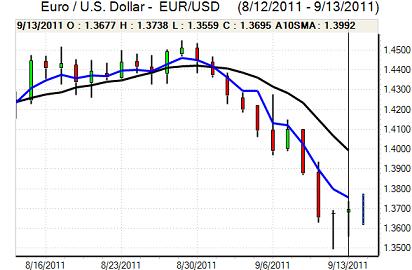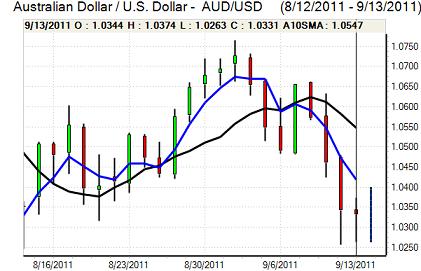EUR/USD
The Euro found support on dips to the 1.3550 area on Tuesday and rallied strongly during the European session with a peak near 1.3750.
There were reports that Germany and France were to issue a joint statement on the Greek situation which underpinned the Euro, but these reports were then denied which pushed the Euro lower again. Reports indicate that a statement was being drafted, but was not approved by the German government. Chancellor Merkel did voice opposition to an uncontrolled Greek default while there were further tensions within the German government. A conference call between Greece, Germany and France is due to be held on Wednesday and there will also be a resumption of the troika talks.
The Italian auction was weaker than expected with 5-year yields rising to the highest level since the Euro’s inception in 1999 at above 5.6%, reinforcing fears the Italian debt profile would quickly move out of control. There were also continuing fears that European banks were facing funding difficulties with a particular focus on France’s exposure. These reports were denied, but there was a further increase in dollar Libor rates which suggested that stresses were continuing to build.
There was a further flow of funds into US Treasuries and the demand for Euro puts was at the highest level for eight years as confidence remained extremely fragile.
There were no major US events during the day with a small increase in the latest IBD consumer confidence reading. The retail sales data will be watched closely on Wednesday, although the immediate impact may be limited as the focus remains firmly on Europe. The Euro retreated again to near 1.36 in Asian trading on Wednesday.

Source: VantagePoint Intermarket Analysis Software
Call now and you will be provided with FREE recent forecasts
that are up to 86% accurate * 800-732-5407
If you would rather have the recent forecasts sent to you, please go here
Yen
The dollar was unable to secure any momentum on Tuesday and consolidated in the 77 region. There was no significant yield support for the dollar even though US Treasury yields did move off recent lows.
The yen continued to gain defensive support from underlying risk aversion and fears over the Euro-zone economy with the Euro again near 10-year lows. With the Swiss National Bank still blocking franc appreciation, there was additional potential demand for the Japanese currency.
There was still speculation over G7 action to prevent yen gains which curbed speculative yen buying interest.
Sterling
After initially finding support near 1.5750, Sterling was blocked near 1.5850 against the dollar on Tuesday and dipped to re-test support near 1.5750 in Asia on Wednesday.
The latest consumer inflation data was in line with market expectations as the headline rate edged higher to 4.5% from 4.4% as utility prices continued to increase. Sterling failed to gain any significant support from the data as there is no prospect of the Bank of England tightening monetary policy. The trade data remained disappointing with the deficit unchanged at GBP8.9bn for July which will dampen any expectations that there will be significant support from exports.
MPC member Posen called for additional policy action in the form of quantitative easing, although he called for international action and not just measures in the UK.
There was still some defensive support for Sterling from its position outside the Euro as UK benchmark bond yields remained at very low levels.
Swiss franc
The dollar was initially blocked in the 0.8880 level against the franc on Tuesday and retreated to lows around 0.8760 before regaining the 0.88 level. The Euro was trapped below the 1.2050 level with no significant bounces during the day.
Although the National Bank action should curb franc buying interest, there will still be the possibility of deposit flows into Swiss financial institutions, especially if there are fears surrounding European banks. In this environment, the effective peg could come under severe pressure, especially if major hedge funds look to take on the bank and its 1.20 minimum Euro level.

Source: VantagePoint Intermarket Analysis Software
Call now and you will be provided with FREE recent forecasts
that are up to 86% accurate * 800-732-5407
If you would rather have the recent forecasts sent to you, please go here
Australian dollar
The Australian dollar was capped below 1.380 against the US currency during Tuesday and after initial firmness late in the US session, it was subjected to heavy selling pressure during Asian trading on Wednesday.
There were continuing fears surrounding the Euro-zone economy and banking sector which had an important impact in undermining risk appetite and also weakened the Australian currency
Domestically, there was a recovery in consumer confidence according to the latest data, but there was also a decline in construction work which reinforced fears over the housing sector.
There was additional speculation that the Reserve Bank would move to an easing bias and the Australian dollar retreated to lows below 1.02 against the US currency.



